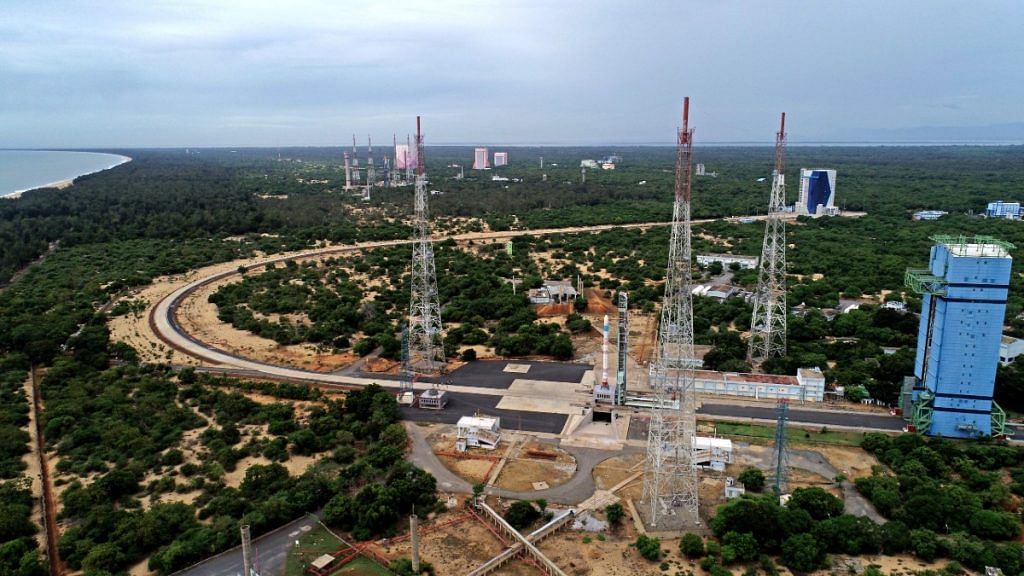Bengaluru: The Indian Space Research Organisation (ISRO) Sunday performed the first demonstration or test flight of its new, smaller rocket, the Small Satellite Launch Vehicle or SSLV. As part of the mission (SSLV-D1), the rocket was supposed to place an earth observation EOS-02 satellite weighing 145 kg and the 8-kg AzaadiSAT student CubeSat — research spacecrafts called nanosatellites — into a 350-km orbit.
While the different parts or stages of the rocket separated successfully, there was some loss of data, likely telemetry data, towards the end of the mission.
“All stages performed as expected. The first stage performed and separated, second stage performed and separated, the third stage also performed and separated, and in the terminal phase of the mission, some data loss is occurring and we are analysing the data and we will comeback on the status of the satellites as well as the vehicle performance soon,” ISRO Chair S. Somanath had said after the launch.
He later clarified in a video statement that the satellites were placed into a 356×76-km elliptical orbit instead of a 350-km circular orbit. Therefore, both satellites are “no longer usable”. The root cause of the issue seems to be a “sensor failure” that went undetected, which should have instead triggered a “salvage action”.
One of the payloads was an earth observation demonstrator, while the other was a student satellite built by 750 girl students from rural government schools across the country.
The SSLV small-life vehicle was launched from Sriharikota on the morning of 7 August, but when operational, is expected to be launched from an upcoming dedicated launch pad in the same location called the Small Satellite Launch Complex (SSLC).
With the launcher, ISRO now has three different vehicles with variable configurations, strengthening its capacity to launch satellites into orbit. The 34-metre high launcher can place payloads of up to 500 kg into a 500-km orbit, and is designed to carry mini, micro, and nano satellites.
The launcher’s next demo flight is scheduled for later this year.
Also Read: How can India get its own Elon Musk? ISRO Chair Somanath says agency has key role to play
Payloads
EOS-02 is an experimental optical remote sensing satellite weighing 145 kg, and will perform earth imaging once in the orbit.
The satellite will demonstrate the ability to build and launch imaging satellites within a short-turnaround time. It is a Microsat series (11-200 kg) of spacecraft.
AzaadiSAT is an 8U cubesat — miniaturised satellites that are 10 cm cubes, with eight of them stacked next to each other. It weighs 8 kg and carries 75 payloads of about 50 g each.
The satellite was built by teams of ten girl students each from 75 rural government schools across the country, and integrated by the team at Space Kidz India.
The student satellite carries payloads like transponders for amateur radio, a radiation counter, a magnetometer, gyroscope, and a host of basic, experimental science instruments.
It also carries a selfie camera, 35,000 children’s names, 108 art pieces about India made by children aged 8-12, a recording of Rabindranath Tagore’s original rendition of the Indian national anthem, and an original space-themed Hindi song.
Inspiration for Indian girls in STEAM
AzaadiSAT was conceptualised by the team at Space Kidz India, who wanted to work with 750 girl students for India’s 75th year of Independence.
The team, headed by Dr Srimathy Kesan, reached out to 350 individual rural government schools across all the states in the country, finally coming up with 75 teams from 75 schools, including a Chennai-based juvenile home. The team was unable to reach any institution in Arunachal Pradesh and Mizoram.
The organization communicated with students over video-conferencing platform Zoom, teaching them to code (Python, Intel 8085) on the electronic boards they had been sent.
Students were also taught basic circuitry and how to work with sensors. The students, many of whom had no access to a computer, enjoyed the process tremendously and many even insisted on seeing the launch despite no financial support.
“Independence is bringing everyone together, and that is what we wanted to do,” Kesan told ThePrint, adding that 462 children came to Chennai for the launch.
“While we tried to bring everyone here, for many, the finances and distances were too unviable for us to work out,” she added.
Kesan’s team funded both computers for the project as well as travel and stay for a majority of the students. Having taken over 3,000 students to space centres in the US and Europe, Kesan’s organization is working towards funding one in Chennai.
“Space is imaginative, and children are very drawn to it. Space is fun, and it can be made exciting to read, learn, and understand for young children,” she said.
“Children from rural villages are very articulate in their own native languages, and they should be also given a platform to come out and speak about their achievements and understanding.”
(This report has been updated with additional inputs)
(Edited by Amrtansh Arora)
Also Read: ISRO-IISc team develops prototype of bacteria-infused bricks for Martian, lunar soil
